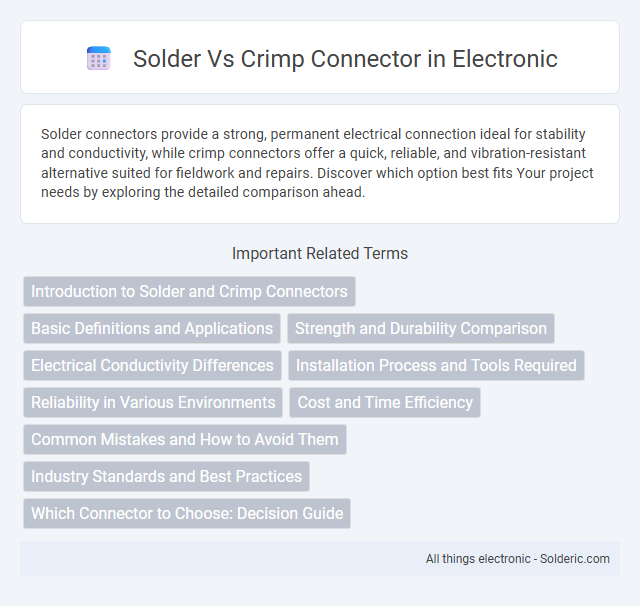Solder connectors provide a strong, permanent electrical connection ideal for stability and conductivity, while crimp connectors offer a quick, reliable, and vibration-resistant alternative suited for fieldwork and repairs. Discover which option best fits Your project needs by exploring the detailed comparison ahead.
Comparison Table
| Feature | Solder Connector | Crimp Connector |
|---|---|---|
| Connection Type | Permanent, fused joint using molten solder | Mechanical, compressed connection using a crimping tool |
| Durability | High electrical conductivity, strong mechanical bond | Reliable under vibration, less conductive than solder |
| Installation Time | Longer, requires heating and cooling | Fast, quick compression process |
| Equipment Needed | Soldering iron, solder, flux | Crimping tool, appropriate connectors |
| Skill Requirement | Moderate to high soldering skills required | Basic to moderate crimping skills sufficient |
| Reliability | Excellent in low vibration environments | Better in high vibration or dynamic conditions |
| Rework | Requires reheating, may damage wire insulation | Easy to cut and re-crimp |
| Applications | Electronics, delicate circuits, audio equipment | Automotive, aerospace, heavy machinery wiring |
Introduction to Solder and Crimp Connectors
Solder connectors create a reliable, permanent electrical connection by melting solder to join wires and terminals, ensuring strong conductivity and durability. Crimp connectors use a mechanical action to deform a metal sleeve around the wire, providing a fast, consistent connection without heat, ideal for fieldwork and quick repairs. Your choice between solder and crimp connectors depends on factors like application environment, required strength, and ease of installation.
Basic Definitions and Applications
Solder connectors involve melting metal alloy to join wires, creating a permanent, electrically conductive bond ideal for low-voltage electronics and precise signal transmission. Crimp connectors mechanically compress metal sleeves onto wires, providing quick, reliable connections often used in automotive wiring and industrial equipment where durability and vibration resistance are critical. Your choice depends on the application's need for ease of installation, maintenance, and the electrical or mechanical performance required.
Strength and Durability Comparison
Solder connectors provide superior electrical conductivity and long-lasting mechanical stability due to a permanent metal bond, making them highly resistant to vibration and corrosion. Crimp connectors offer efficient installation and good tensile strength but may be prone to loosening or failure under extreme mechanical stress or frequent movement without proper quality tools. Overall, soldering ensures maximum durability in high-stress or harsh environments, whereas crimping balances ease of use with reliable performance in less demanding applications.
Electrical Conductivity Differences
Solder connectors provide superior electrical conductivity due to the metallurgical bond formed between the wire and connector, reducing resistance and minimizing signal loss. Crimp connectors rely on mechanical deformation to create a secure connection, which may introduce micro-gaps and slightly higher resistance compared to soldered joints. Choosing solder over crimp ensures optimal conductivity in high-performance electrical and electronic applications.
Installation Process and Tools Required
Solder connectors require heating tools such as a soldering iron, solder wire, and flux to melt and join metal surfaces, ensuring a strong, electrically conductive bond, while the installation process demands precise temperature control and technique. Crimp connectors use a specialized crimping tool to mechanically compress a metal sleeve around wires, providing a secure physical and electrical connection without heat; this method is faster and often preferred for fieldwork or mass production. Both methods necessitate careful wire preparation, but crimping generally involves less training and equipment, making it advantageous for consistent, quick installations.
Reliability in Various Environments
Solder connectors provide superior reliability in various environments due to their permanent, solid metal bonds that resist vibration, moisture, and corrosion effectively. Crimp connectors, while quicker to install, may be more vulnerable to environmental factors such as temperature fluctuations and mechanical stress, which can cause intermittent connections over time. Your choice depends on the environmental conditions and required durability, with solder connectors often preferred for high-reliability applications.
Cost and Time Efficiency
Crimp connectors typically offer greater time efficiency compared to solder connectors, as they require less preparation and curing time, making them ideal for high-volume or rapid assembly workflows. Solder connectors tend to be more cost-effective for small-scale projects due to the lower initial investment in tools and materials, though the longer process can increase labor costs. Your choice between solder and crimp connectors should balance upfront expenses with the total time spent on installation to optimize both cost and efficiency.
Common Mistakes and How to Avoid Them
Common mistakes when using solder connectors include overheating the wire, leading to brittle joints, and applying excessive solder, which can cause shorts or unreliable connections. In crimp connectors, failures often result from improper tool selection or insufficient pressure, causing loose or damaged terminals. To ensure reliable connections, you should select the right tool for your connector type and practice consistent techniques tailored to soldering or crimping applications.
Industry Standards and Best Practices
Solder connectors comply with IPC-610 standards, ensuring reliable electrical continuity and mechanical strength in high-vibration environments, while crimp connectors follow MIL-DTL-22520 specifications for consistent gas-tight and corrosion-resistant terminations. Best practices recommend soldering for permanent, high-reliability connections where thermal or mechanical stresses are minimal and crimping for field serviceability and quick assembly in aerospace and automotive industries. Both methods require precise tooling and inspection protocols to meet industry quality certifications such as UL, RoHS, and ISO 9001.
Which Connector to Choose: Decision Guide
Choosing between solder and crimp connectors depends on the application's reliability requirements and environmental conditions. Solder connectors provide superior electrical conductivity and mechanical strength, making them ideal for permanent, high-vibration environments, while crimp connectors offer faster installation, ease of rework, and consistent performance suited for mass production and maintenance tasks. Evaluate factors such as equipment lifespan, exposure to moisture or vibration, and technician skill level to select the appropriate connector type for optimized electrical joint integrity.
Solder vs Crimp connector Infographic

 solderic.com
solderic.com